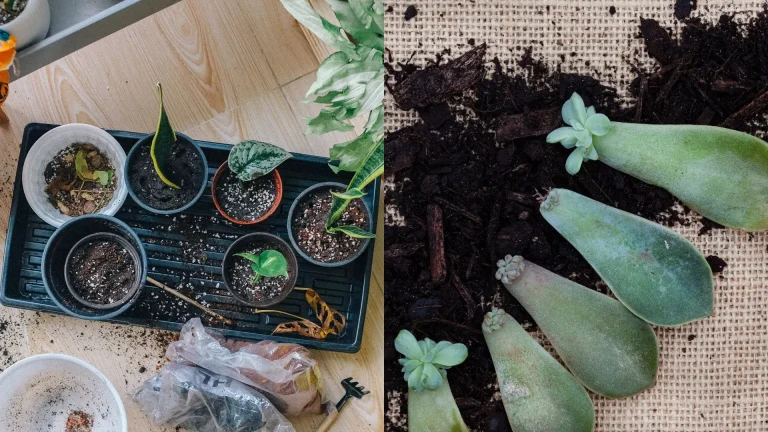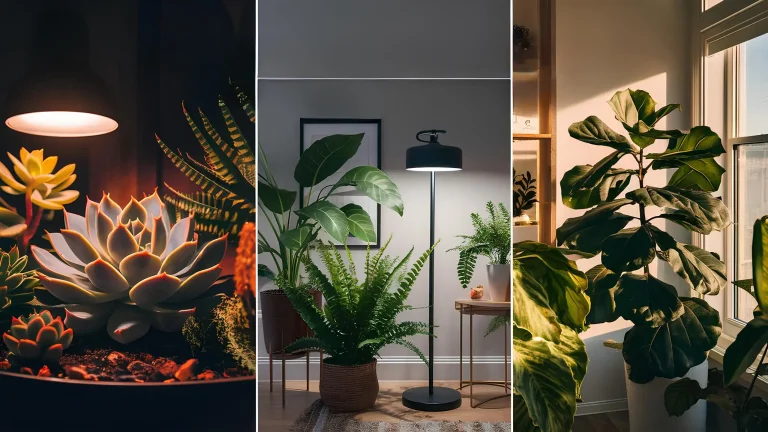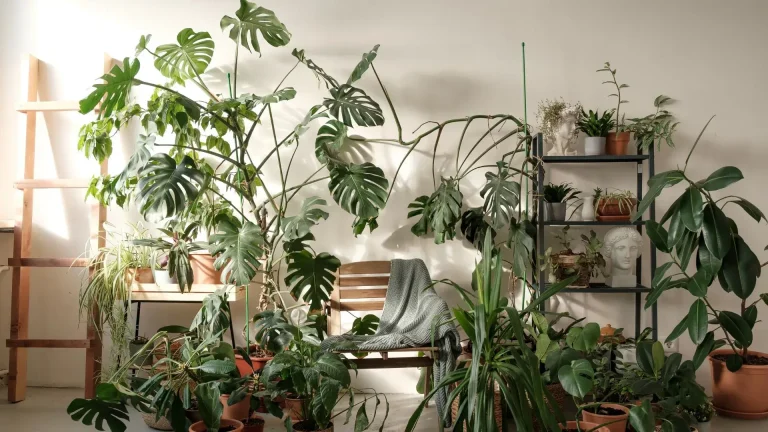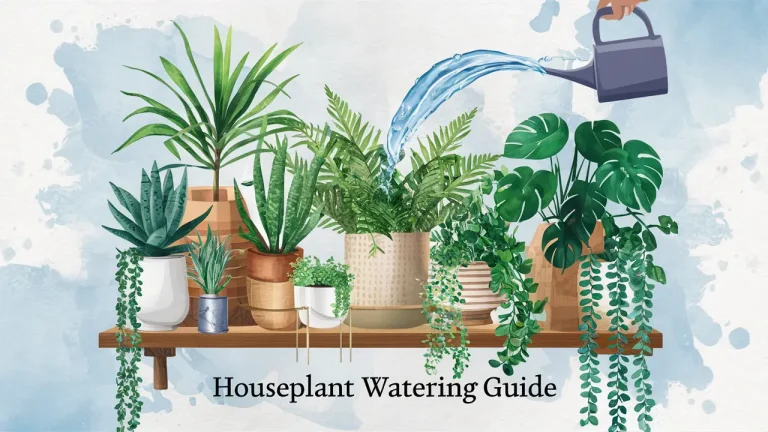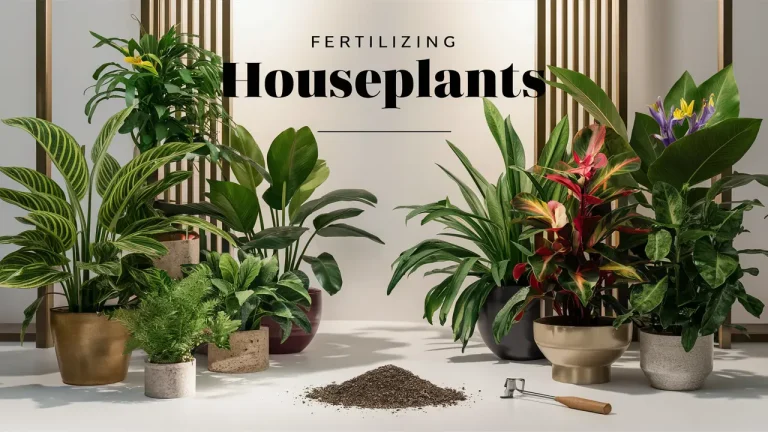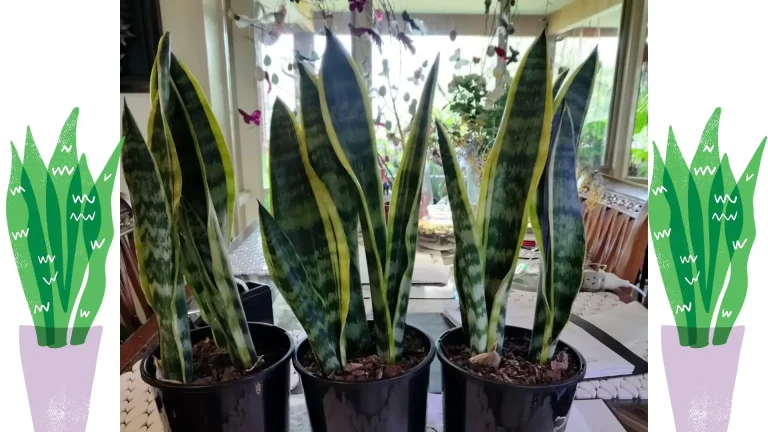Houseplant Temperature Guide: Tips to Protect Your Plants in Any Season
This guide will help you understand the role of temperature in plant health, identify the ideal temperature ranges for different houseplants, and provide practical tips to maintain the right conditions. Whether you’re caring for tropical beauties, hardy succulents, or delicate ferns, you’ll learn how to adjust your indoor environment to meet their unique needs.
Table of Contents
Understanding Temperature and Plant Physiology
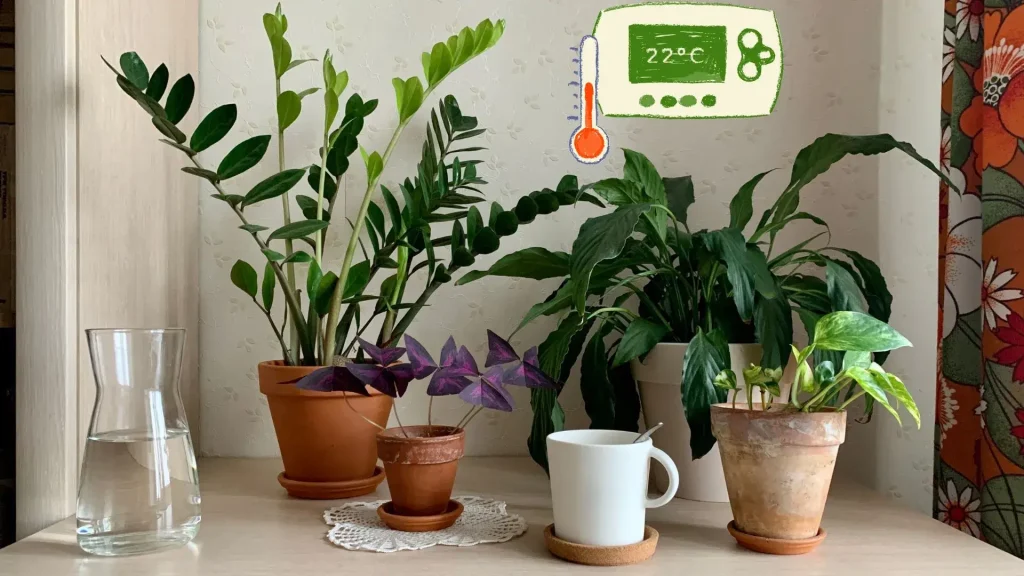
How Temperature Influences Plant Processes
Plants depend on temperature for critical physiological functions:
- Photosynthesis: Plants use sunlight to convert carbon dioxide and water into energy. Optimal temperatures maximize this process, while extreme heat or cold can slow it down or stop it entirely.
- Respiration: This process breaks down sugars to release energy for growth and repair. High temperatures can increase respiration rates, potentially depleting energy reserves if not balanced with photosynthesis.
- Transpiration: Plants release water vapor through their leaves, which helps them cool down and transport nutrients. Temperature affects how quickly this occurs, with high heat causing rapid water loss and low temperatures slowing nutrient movement.
Temperature Ranges
- Optimal Growth Temperatures:
- Most houseplants thrive in temperatures between 65°F and 75°F (18°C to 24°C) during the day and 55°F to 65°F (13°C to 18°C) at night.
- Maintaining consistent temperatures within this range ensures healthy growth.
- Tolerance to Temperature Extremes:
- High Temperatures: Some plants can withstand heat but may wilt or show signs of dehydration if exposed for extended periods.
- Low Temperatures: Exposure to cold drafts or frost can damage leaves, slow growth, and harm roots. Tropical plants are especially sensitive to temperatures below 50°F (10°C).
Categorizing Houseplants by Temperature Preferences
Cool Temperature Plants
- Characteristics: These plants thrive in cooler indoor environments, typically below 65°F (18°C). They’re ideal for homes with lower heating in winter or naturally cooler spaces.
- Examples:
- Snake Plant (Sansevieria)
- Spider Plant (Chlorophytum comosum)
- Cast Iron Plant (Aspidistra elatior)
- Care Tips:
- Keep them away from direct heat sources like radiators.
- Avoid overwatering, as cooler conditions can slow water absorption.
Medium (Intermediate) Temperature Plants
- Characteristics: These plants prefer moderate, stable temperatures ranging from 65°F to 75°F (18°C to 24°C). They are well-suited for most indoor environments.
- Examples:
- Monstera Deliciosa
- Peace Lily (Spathiphyllum)
- Pothos (Epipremnum aureum)
- Care Tips:
- Maintain consistent temperatures, avoiding sudden fluctuations.
- Provide bright, indirect light to complement their temperature needs.
Warm Temperature Plants
- Characteristics: These species thrive in warmer conditions, often above 75°F (24°C). They mimic the tropical and subtropical climates where these plants naturally grow.
- Examples:
- Fiddle-Leaf Fig (Ficus lyrata)
- Calathea varieties
- Anthuriums
- Care Tips:
- Keep them in rooms with higher humidity to match their warm temperature needs.
- Ensure proper ventilation to avoid overheating in enclosed spaces.
Grab my printable plant care tracker to monitor temperature, humidity, watering, light, and more!
Seasonal Temperature Variations and Their Impact
Seasonal changes can significantly affect the indoor environment, altering the temperature conditions your houseplants experience. Understanding how to adapt your care routine to these changes is crucial for maintaining healthy plants throughout the year.
Adapting to Seasonal Changes
- Spring and Fall:
- These transitional seasons often bring stable temperatures, making them ideal for plant growth.
- Adjust watering schedules as plants may start or slow their active growth phases.
- Ensure consistent temperatures by avoiding open windows during cool nights.
- Summer:
- Higher temperatures and increased sunlight can boost plant growth, but they can also lead to overheating.
- Keep plants away from direct sunlight to prevent leaf scorching.
- Monitor soil moisture levels more frequently, as water evaporates faster in warm conditions.
- Winter:
- Indoor heating systems can create dry, warm air that impacts humidity and temperature.
- Protect plants from cold drafts near windows or doors.
- For tropical plants, use a humidifier to counteract dry indoor air.
Protecting Plants from Temperature Extremes
Cold Temperatures
Cold conditions can cause plant cells to freeze, leading to blackened, wilted leaves or even plant death.
- Signs of Cold Damage:
- Black or mushy leaves.
- Drooping stems.
- Delayed or stunted growth.
- Protection Tips:
- Move plants away from windowsills on cold nights.
- Use curtains or blinds to insulate against cold drafts.
- For extreme cold, consider moving sensitive plants to warmer rooms.
Hot Temperatures
Excess heat can dehydrate plants quickly and disrupt their ability to perform essential processes.
- Signs of Heat Stress:
- Wilting leaves despite moist soil.
- Crispy, browning edges.
- Accelerated leaf drop.
- Protection Tips:
- Place plants in rooms with good ventilation.
- Avoid placing pots near heat sources like ovens or radiators.
- Provide shade or filtered light during heat waves.
Tools for Monitoring and Regulating Temperature
Investing in tools to monitor and adjust temperature can make a big difference in maintaining a stable environment for your houseplants.
Monitoring Tools
- Digital Thermometers:
- Provide accurate temperature readings.
- Compact and easy to use near plants.
- Hygrometers:
- Measure both temperature and humidity, offering a complete picture of your plant’s environment.
Regulating Tools
- Heating Mats:
- Useful for plants during winter or for propagation.
- Provide consistent warmth to the root zone.
- Fans:
- Improve air circulation and prevent heat buildup in warm conditions.
- Grow Lights:
- Maintain optimal temperatures in cooler months by simulating sunlight.
Practical Tips for Maintaining Ideal Temperatures
- Create Microclimates:
- Group plants with similar temperature needs together to create stable conditions.
- Use glass cabinets or terrariums for tropical plants requiring consistent warmth.
- Avoid Temperature Shocks:
- Gradually acclimate plants to new temperature conditions when moving them between rooms or outdoors.
- Use insulation like bubble wrap for pots near cold windows in winter.
- Regular Monitoring:
- Check temperature levels daily during extreme weather changes.
- Adjust placement or tools (like humidifiers) as needed to maintain consistency.
Special Considerations for Specific Plant Types
Different houseplants have unique temperature requirements based on their native habitats. Understanding these specifics helps you create the perfect conditions for their growth.
Tropical Plants
- Examples: Monstera, philodendron, calathea, peace lily.
- Temperature Needs:
- Daytime: 65–85°F (18–29°C).
- Nighttime: No lower than 55°F (13°C).
- Tips for Care:
- Keep tropical plants away from cold drafts, especially in winter.
- Pair temperature control with high humidity for best results.
- Use a humidifier or create a greenhouse effect with plastic coverings during colder months.
Succulents and Cacti
- Examples: Aloe vera, echeveria, jade plant, cactus species.
- Temperature Needs:
- Daytime: 70–85°F (21–29°C).
- Nighttime: Can tolerate temperatures as low as 50°F (10°C).
- Tips for Care:
- Place succulents in a bright, warm spot to mimic desert-like conditions.
- Avoid overwatering, as cooler temperatures slow evaporation.
- Protect against frost if kept outdoors by bringing them inside during cold spells.
Flowering Houseplants
- Examples: Anthurium, African violets, orchids.
- Temperature Needs:
- Daytime: 60–75°F (16–24°C).
- Nighttime: Slightly cooler than daytime but not below 50°F (10°C).
- Tips for Care:
- Maintain consistent temperatures to encourage blooming cycles.
- Avoid placing these plants near vents or heaters that might dry out buds or flowers.
Ferns
- Examples: Boston fern, maidenhair fern, asparagus fern.
- Temperature Needs:
- Daytime: 60–75°F (16–24°C).
- Nighttime: No lower than 55°F (13°C).
- Tips for Care:
- Combine warm temperatures with high humidity to prevent browning fronds.
- Avoid sudden temperature drops, which can lead to leaf drop.
Woody Plants
- Examples: Fiddle-leaf fig, rubber plant, ficus trees.
- Temperature Needs:
- Daytime: 65–75°F (18–24°C).
- Nighttime: Not below 55°F (13°C).
- Tips for Care:
- Position away from cold drafts or direct heat sources.
- Rotate the plant periodically to ensure even growth in consistent temperatures.
Final Thoughts
Temperature plays a crucial role in maintaining healthy, thriving houseplants. By understanding the specific needs of your plants and how seasonal and environmental factors affect their growth, you can create an optimal indoor environment.
This guide has covered everything from the basics of temperature and plant physiology to practical tips for managing seasonal changes and catering to specific plant types. With the right tools and techniques, you can confidently care for your plants year-round and watch them flourish.
Encourage your inner plant parent to observe, adjust, and experiment with temperature management—and enjoy the lush, vibrant results!

